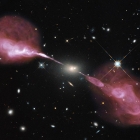Radiating Accretion Disks and Relativistic Jets from Rotating Black Holes
General relativistic magnetohydrodynamic simulations of black hole accretion systems has led to significant progress in our understanding of disks and jets, but a major missing piece of physics has been the treatment of radiation. We discuss our approach to the inclusion of radiation that handles general optical depths with no code performance hit. Our radiative simulations show that black holes can accrete at arbitrary mass accretion rates, while the total radiative output always stays below Eddington. At sufficiently high BH spin,the electromagnetic output from the Blandford-Znajek effect dominates the radiative output. The radiation emerges from the polar region and so the implied isotropic equivalent luminosity is greatly enhanced beyond Eddington. These results have implications for the cosmological growth and of black holes and how their spin evolves, large-scale structure formation via active galactic nuclei (AGN) feedback, our interpretations of ultraluminous x-ray sources (ULXs), and our general understanding systems accreting at or near Eddington (tidal disruption events (TDEs), quasars, gamma-ray bursts, etc.).

